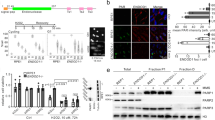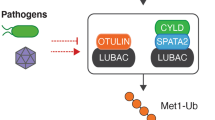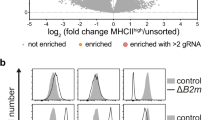Abstract
Here we have identified 'triple D' (3d), a recessive N-ethyl-N-nitrosourea-induced mutation and phenotype in which no signaling occurs via the intracellular Toll-like receptors 3, 7 and 9 (sensors for double-stranded RNA, single-stranded RNA and unmethylated DNA, respectively). The 3d mutation also prevented cross-presentation and diminished major histocompatibility complex class II presentation of exogenous antigen; it also caused hypersusceptibility to infection by mouse cytomegalovirus and other microbes. By positional identification, we found 3d to be a missense allele of Unc93b1, which encodes the 12-membrane-spanning protein UNC-93B, a highly conserved molecule found in the endoplasmic reticulum with multiple paralogs in mammals. Innate responses to nucleic acids and exogenous antigen presentation, which both initiate in endosomes, thus seem to depend on an endoplasmic reticulum–resident protein, which suggests communication between these organellar systems.
This is a preview of subscription content, access via your institution
Access options
Subscribe to this journal
Receive 12 print issues and online access
$209.00 per year
only $17.42 per issue
Buy this article
- Purchase on SpringerLink
- Instant access to full article PDF
Prices may be subject to local taxes which are calculated during checkout





Similar content being viewed by others
References
Poltorak, A. et al. Defective LPS signaling in C3H/HeJ and C57BL/10ScCr mice: mutations in Tlr4 gene. Science 282, 2085–2088 (1998).
Takeuchi, O. et al. Preferentially the R-stereoisomer of the mycoplasmal lipopeptide macrophage-activating lipopeptide-2 activates immune cells through a Toll-Like receptor 2- and MyD88-dependent signaling pathway. J. Immunol. 164, 554–557 (2000).
Takeuchi, O. et al. Discrimination of bacterial lipoproteins by Toll-like receptor 6. Int. Immunol. 13, 933–940 (2001).
Gantner, B.N., Simmons, R.M., Canavera, S.J., Akira, S. & Underhill, D.M. Collaborative induction of inflammatory responses by dectin-1 and Toll-like receptor 2. J. Exp. Med. 197, 1107–1117 (2003).
Hayashi, F. et al. The innate immune response to bacterial flagellin is mediated by Toll- like receptor 5. Nature 410, 1099–1103 (2001).
Hemmi, H. et al. A Toll-like receptor recognizes bacterial DNA. Nature 408, 740–745 (2000).
Alexopoulou, L., Holt, A.C., Medzhitov, R. & Flavell, R.A. Recognition of double-stranded RNA and activation of NF-κB by Toll-like receptor 3. Nature 413, 732–738 (2001).
Diebold, S.S., Kaisho, T., Hemmi, H., Akira, S. & Reis e Sousa, C. Innate antiviral responses by means of TLR7-mediated recognition of single-stranded RNA. Science 303, 1529–1531 (2004).
Heil, F. et al. Species-specific recognition of single-stranded RNA via Toll-like receptor 7 and 8. Science 303, 1526–1529 (2004).
Lund, J.M. et al. Recognition of single-stranded RNA viruses by Toll-like receptor 7. Proc. Natl. Acad. Sci. USA 101, 5598–5603 (2004).
Matsumoto, M. et al. Subcellular localization of Toll-like receptor 3 in human dendritic cells. J. Immunol. 171, 3154–3162 (2003).
Funami, K. et al. The cytoplasmic 'linker region' in Toll-like receptor 3 controls receptor localization and signaling. Int. Immunol. 16, 1143–1154 (2004).
Ahmad-Nejad, P. et al. Bacterial CpG-DNA and lipopolysaccharides activate Toll-like receptors at distinct cellular compartments. Eur. J. Immunol. 32, 1958–1968 (2002).
Leifer, C.A. et al. TLR9 is localized in the endoplasmic reticulum prior to stimulation. J. Immunol. 173, 1179–1183 (2004).
Latz, E. et al. TLR9 signals after translocating from the ER to CpG DNA in the lysosome. Nat. Immunol. 5, 190–198 (2004).
Heil, F. et al. The Toll-like receptor 7 (TLR7)-specific stimulus loxoribine uncovers a strong relationship within the TLR7, 8 and 9 subfamily. Eur. J. Immunol. 33, 2987–2997 (2003).
Beutler, B. Inferences, questions and possibilities in Toll-like receptor signalling. Nature 430, 257–263 (2004).
Hoebe, K. et al. Upregulation of costimulatory molecules induced by lipopolysaccharide and double-stranded RNA occurs by Trif-dependent and Trif-independent pathways. Nat. Immunol. 4, 1223–1229 (2003).
Jenkins, M.K., Taylor, P.S., Norton, S.D. & Urdahl, K.B. CD28 delivers a costimulatory signal involved in antigen-specific IL-2 production by human T cells. J. Immunol. 147, 2461–2466 (1991).
Azuma, M., Cayabyab, M., Buck, D., Phillips, J.H. & Lanier, L.L. CD28 interaction with B7 costimulates primary allogeneic proliferative responses and cytotoxicity mediated by small, resting T lymphocytes. J. Exp. Med. 175, 353–360 (1992).
Chen, L. et al. Costimulation of antitumor immunity by the B7 counterreceptor for the T lymphocyte molecules CD28 and CTLA-4. Cell 71, 1093–1102 (1992).
Borriello, F. et al. B7–1 and B7–2 have overlapping, critical roles in immunoglobulin class switching and germinal center formation. Immunity 6, 303–313 (1997).
Pamer, E. & Cresswell, P. Mechanisms of MHC class I–restricted antigen processing. Annu. Rev. Immunol. 16, 323–358 (1998).
Cresswell, P. Assembly, transport, and function of MHC class II molecules. Annu. Rev. Immunol. 12, 259–293 (1994).
Hoebe, K. et al. CD36 is a sensor of diacylglycerides. Nature 433, 523–527 (2005).
Jiang, Z. et al. CD14 is required for MyD88-independent LPS signaling. Nat. Immunol. 6, 565–570 (2005).
Tabeta, K. et al. Toll-like receptors 9 and 3 as essential components of innate immune defense against mouse cytomegalovirus infection. Proc. Natl. Acad. Sci. USA 101, 3516–3521 (2004).
Hoebe, K. et al. Identification of Lps2 as a key transducer of MyD88-independent TIR signaling. Nature 424, 743–748 (2003).
Edelson, B.T. & Unanue, E.R. MyD88-dependent but Toll-like receptor 2-independent innate immunity to Listeria: no role for either in macrophage listericidal activity. J. Immunol. 169, 3869–3875 (2002).
McCaffrey, R.L. et al. A specific gene expression program triggered by Gram-positive bacteria in the cytosol. Proc. Natl. Acad. Sci. USA 101, 11386–11391 (2004).
Serbina, N.V. et al. Sequential MyD88-independent and -dependent activation of innate immune responses to intracellular bacterial infection. Immunity 19, 891–901 (2003).
Martinson, J.J., Chapman, N.H., Rees, D.C., Liu, Y.T. & Clegg, J.B. Global distribution of the CCR5 gene 32-basepair deletion. Nat. Genet. 16, 100–103 (1997).
Janssen, E.M. et al. CD4+ T-cell help controls CD8+ T-cell memory via TRAIL-mediated activation-induced cell death. Nature 434, 88–93 (2005).
Sureau, A. et al. Characterization of multiple alternative RNAs resulting from antisense transcription of the PR264/SC35 splicing factor gene. Nucleic Acids Res. 25, 4513–4522 (1997).
Krug, A. et al. TLR9-dependent recognition of MCMV by IPC and DC generates coordinated cytokine responses that activate antiviral NK cell function 3. Immunity 21, 107–119 (2004).
Greenwald, I.S. & Horvitz, H.R. unc-93(e1500): A behavioral mutant of Caenorhabditis elegans that defines a gene with a wild-type null phenotype. Genetics 96, 147–164 (1980).
Levin, J.Z. & Horvitz, H.R. The Caenorhabditis elegans unc-93 gene encodes a putative transmembrane protein that regulates muscle contraction. J. Cell Biol. 117, 143–155 (1992).
de la Cruz, I., Levin, J.Z., Cummins, C., Anderson, P. & Horvitz, H.R. sup-9, sup-10, and unc-93 may encode components of a two-pore K+ channel that coordinates muscle contraction in Caenorhabditis elegans. J. Neurosci. 23, 9133–9145 (2003).
Bayliss, D.A., Sirois, J.E. & Talley, E.M. The TASK family: two-pore domain background K+ channels. Mol. Interv. 3, 205–219 (2003).
Samson, M. et al. Resistance to HIV-1 infection in caucasian individuals bearing mutant alleles of the CCR-5 chemokine receptor gene. Nature 382, 722–725 (1996).
MacFarlane, D.E. & Manzel, L. Antagonism of immunostimulatory CpG-oligodeoxynucleotides by quinacrine, chloroquine, and structurally related compounds. J. Immunol. 160, 1122–1131 (1998).
Lee, J. et al. Molecular basis for the immunostimulatory activity of guanine nucleoside analogs: activation of Toll-like receptor 7. Proc. Natl. Acad. Sci. USA 100, 6646–6651 (2003).
Hacker, H. et al. CpG-DNA-specific activation of antigen-presenting cells requires stress kinase activity and is preceded by non-specific endocytosis and endosomal maturation. EMBO J. 17, 6230–6240 (1998).
Manzel, L., Strekowski, L., Ismail, F.M., Smith, J.C. & MacFarlane, D.E. Antagonism of immunostimulatory CpG-oligodeoxynucleotides by 4-aminoquinolines and other weak bases: mechanistic studies. J. Pharmacol. Exp. Ther. 291, 1337–1347 (1999).
de Bouteiller, O. et al. Recognition of double-stranded RNA by human toll-like receptor 3 and downstream receptor signaling requires multimerization and an acidic pH. J. Biol. Chem. 280, 38133–38145 (2005).
Beutler, B. The Toll-like receptors: analysis by forward genetic methods. Immunogenetics 57, 385–392 (2005).
Akira, S. & Takeda, K. Toll-like receptor signalling. Nat. Rev. Immunol. 4, 499–511 (2004).
Leadbetter, E.A., Rifkin, I.R. & Marshak-Rothstein, A. Toll-like receptors and activation of autoreactive B cells. Curr. Dir. Autoimmun. 6, 105–122 (2003).
Viglianti, G.A. et al. Activation of autoreactive B cells by CpG dsDNA. Immunity 19, 837–847 (2003).
Leadbetter, E.A. et al. Chromatin-IgG complexes activate B cells by dual engagement of IgM and Toll-like receptors. Nature 416, 603–607 (2002).
Hoebe, K., Du, X., Goode, J., Mann, N. & Beutler, B. Lps2: a new locus required for responses to lipopolysaccharide, revealed by germline mutagenesis and phenotypic screening. J. Endotoxin Res. 9, 250–255 (2003).
Orange, J.S. & Biron, C.A. Characterization of early IL-12, IFN-α/β, and TNF effects on antiviral state and NK cell responses during murine cytomegalovirus infection. J. Immunol. 156, 4746–4756 (1996).
Jankowski, A., Scott, C.C. & Grinstein, S. Determinants of the phagosomal pH in neutrophils. J. Biol. Chem. 277, 6059–6066 (2002).
Schapiro, F.B. & Grinstein, S. Determinants of the pH of the Golgi complex. J. Biol. Chem. 275, 21025–21032 (2000).
Porgador, A., Yewdell, J.W., Deng, Y., Bennink, J.R. & Germain, R.N. Localization, quantitation, and in situ detection of specific peptide-MHC class I complexes using a monoclonal antibody. Immunity 6, 715–726 (1997).
Acknowledgements
We thank C.C. Scott (HSC), L. Yu (HSC) and A. Kiemer (University of California, San Diego) for help and advice. Supported by the National Institutes of Health, Canadian Institutes of Health Research, Uehara Memorial Foundation (K.T.) and Leukemia and Lymphoma Society (3248-05 to E.J.).
Author information
Authors and Affiliations
Corresponding author
Ethics declarations
Competing interests
The authors declare no competing financial interests.
Supplementary information
Supplementary Fig. 1
3d/3d mice are unable to contain Gram-positive S. aureus infection. (PDF 190 kb)
Supplementary Fig. 2
Coarse microsatellite mapping of the 3d locus. (PDF 25 kb)
Supplementary Fig. 3
Fine genetic mapping of 3d region. (PDF 24 kb)
Supplementary Fig. 4
SNPs and a novel microsatellite marker used to confine the 3d critical region. (PDF 28 kb)
Supplementary Fig. 5
Illustration of 3d critical region. (PDF 30 kb)
Supplementary Fig. 6
Consed display (http://www.phrap.org) of the mutation in Unc93b1. (PDF 134 kb)
Supplementary Fig. 7
Alignment of the orthologous sequences from vertebrate and invertebrate species in the region of the mutation (boxed). (PDF 124 kb)
Supplementary Fig. 8
Optimal alignment (Clustal-W) between UNC-93A and UNC-93B proteins. (PDF 173 kb)
Rights and permissions
About this article
Cite this article
Tabeta, K., Hoebe, K., Janssen, E. et al. The Unc93b1 mutation 3d disrupts exogenous antigen presentation and signaling via Toll-like receptors 3, 7 and 9. Nat Immunol 7, 156–164 (2006). https://doi.org/10.1038/ni1297
Received:
Accepted:
Published:
Issue Date:
DOI: https://doi.org/10.1038/ni1297



